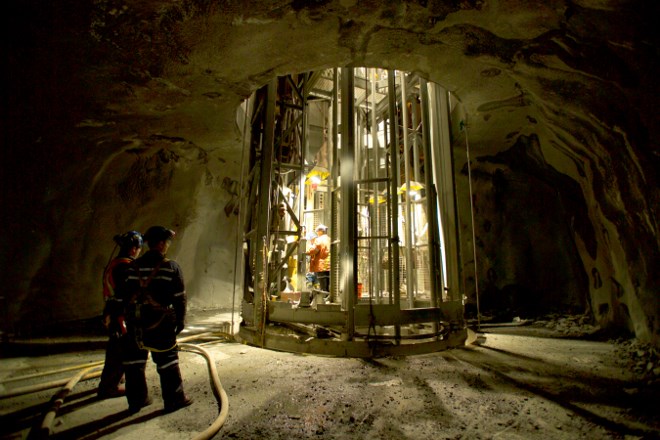A new technology developed by Cementation in North Bay is holding promise as an alternative for bringing ore mined underground up to the surface.
Created as a more efficient, cost-effective option to existing models that employ ramps or vertical shaft systems, “injection joisting” transports ore to the surface using a pump-driven pipeline loop.
Cementation president Roy Slack said the technology has real potential to bring substantial value to the industry.
“Any time you can impact the capital and operating costs, not only does it mean that existing mines become more efficient, but it can also make the difference between a marginal mine and a profitable mine,” Slack said.
“Some orebodies that may not get developed, this may be a method that allows them to get developed, so that means jobs, that means value creation.”
The company has been working on the technology for roughly the last five years, but it came to the forefront of the industry in early March when it was selected to share the $1-million top prize — out of 153 submissions — with Kore Geosystems in the Disrupt Mining contest.
Sponsored by Goldcorp and Integra Gold Corp., Disrupt Mining was designed to showcase individuals, groups and companies that are using exponential technology and disruptive concepts to address challenges faced by the mining industry.
Cementation also earned the Peoples’ Choice Award, adding another $50,000 to its total prize winnings.
Injection hoisting, initiated by Cementation’s technical director, Alun Price Jones, uses a combination of existing and proven crushing, pumping and slurry technologies.
Formerly employed in fields that drilled for geothermal power exploration and radioactive waste disposal encasement repositories, Price Jones was familiar with the concept of reverse circulation — which uses a system of rods and compressed air to return drill cuttings to surface — and hypothesized the same concept could be applied to mining.
“If you can drill a 3-kilometre-deep borehole and bring the broken rock from the bottom of the borehole to surface, then why doesn't that physics principle work likewise for moving mine product?” Price Jones said.
But a challenge remained: how to get the broken rock into the circulating system so it could enter the fluid flow. The crew at Cementation found the answer was to blend the flow of broken rock with the circulating mud and blend the flow with the injector.
Though Cementation is popularizing the concept, similar models have been tried before. A model in South Africa used a system of opened and closed valves to send batches through the pipeline. But the density of the material caused frequent blockages.
A different system tried in Ontario employed an airlock system, but it also got choked up fairly easily due to the bulk of the material.
Cementation believes part of the answer for a successful continuous-flow operation is minimizing the size of the particles going through the system to no more than two or three inches (50 to 75 millimetres).
“When we stepped back from it to see what we were trying to do, what it requires is to introduce the rockload into the pipeline system in a measured way that takes good control of the density of the slurry and doesn't allow the slurry to become overly dense to the point that it becomes prone to blockage,” Price Jones said.
“We feel that, with our injection system, this really is the nub of it; the injection system provides that level of control and it's an arrangement that is novel in its own right.”
Price Jones believes the cost of the system could come in at one-tenth of the cost of trucking ore to the surface.
Now that Cementation has the industry’s attention, the next step is to build a full-scale prototype to fully test the technology.
Slack said the company will fund part of that phase internally, in addition to applying for some mining innovation grant funding. But the more pressing issue is to partner with a mining company, or companies, that can provide a mine in which to build the prototype.
“We’re not really looking at any exclusivity here, so the potential is to team up with a number of mining companies and together develop something to help the industry as a whole,” Slack said.
“That’s still a discussion we need to have, but a few of the mining companies have expressed interest in that.”
In preliminary discussions, mining companies have suggested that the technology could even be applied to other areas of the industry.
“A collaborative approach is just going to lead to more opportunities and more benefits from the system,” Slack said. “So we are looking forward to getting involved in more detail with a couple of mining partners.”
He estimates the prototype could be built within the next year, and, if testing goes well, commercial application could be reached within 18 months.




